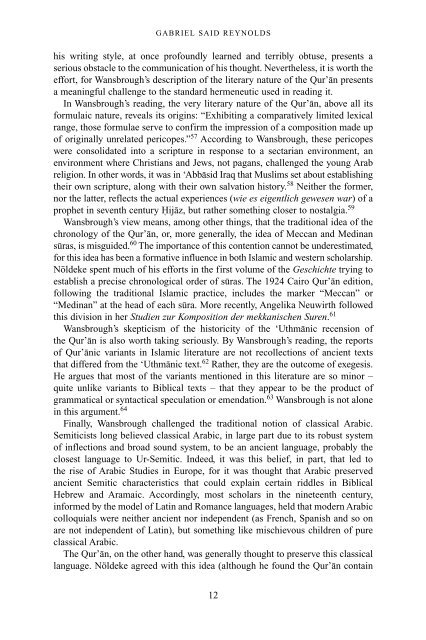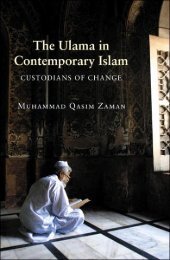The Qur'an in its historical context (pdf - Islam and Christian-Muslim ...
The Qur'an in its historical context (pdf - Islam and Christian-Muslim ...
The Qur'an in its historical context (pdf - Islam and Christian-Muslim ...
You also want an ePaper? Increase the reach of your titles
YUMPU automatically turns print PDFs into web optimized ePapers that Google loves.
GABRIEL SAID REYNOLDS<br />
his writ<strong>in</strong>g style, at once profoundly learned <strong>and</strong> terribly obtuse, presents a<br />
serious obstacle to the communication of his thought. Nevertheless, it is worth the<br />
effort, for Wansbrough’s description of the literary nature of the Qur’an presents<br />
a mean<strong>in</strong>gful challenge to the st<strong>and</strong>ard hermeneutic used <strong>in</strong> read<strong>in</strong>g it.<br />
In Wansbrough’s read<strong>in</strong>g, the very literary nature of the Qur’an, above all <strong>its</strong><br />
formulaic nature, reveals <strong>its</strong> orig<strong>in</strong>s: “Exhibit<strong>in</strong>g a comparatively limited lexical<br />
range, those formulae serve to confirm the impression of a composition made up<br />
of orig<strong>in</strong>ally unrelated pericopes.” 57 Accord<strong>in</strong>g to Wansbrough, these pericopes<br />
were consolidated <strong>in</strong>to a scripture <strong>in</strong> response to a sectarian environment, an<br />
environment where <strong>Christian</strong>s <strong>and</strong> Jews, not pagans, challenged the young Arab<br />
religion. In other words, it was <strong>in</strong> ‘Abbasid Iraq that <strong>Muslim</strong>s set about establish<strong>in</strong>g<br />
their own scripture, along with their own salvation history. 58 Neither the former,<br />
nor the latter, reflects the actual experiences (wie es eigentlich gewesen war) of a<br />
prophet <strong>in</strong> seventh century Hijaz, but rather someth<strong>in</strong>g closer to nostalgia. 59<br />
Wansbrough’s view means, among other th<strong>in</strong>gs, that the traditional idea of the<br />
chronology of the Qur’an, or, more generally, the idea of Meccan <strong>and</strong> Med<strong>in</strong>an<br />
suras, is misguided. 60 <strong>The</strong> importance of this contention cannot be underestimated,<br />
for this idea has been a formative <strong>in</strong>fluence <strong>in</strong> both <strong>Islam</strong>ic <strong>and</strong> western scholarship.<br />
Nöldeke spent much of his efforts <strong>in</strong> the first volume of the Geschichte try<strong>in</strong>g to<br />
establish a precise chronological order of suras. <strong>The</strong> 1924 Cairo Qur’an edition,<br />
follow<strong>in</strong>g the traditional <strong>Islam</strong>ic practice, <strong>in</strong>cludes the marker “Meccan” or<br />
“Med<strong>in</strong>an” at the head of each sura. More recently, Angelika Neuwirth followed<br />
this division <strong>in</strong> her Studien zur Komposition der mekkanischen Suren. 61<br />
Wansbrough’s skepticism of the historicity of the ‘Uthmanic recension of<br />
the Qur’an is also worth tak<strong>in</strong>g seriously. By Wansbrough’s read<strong>in</strong>g, the reports<br />
of Qur’anic variants <strong>in</strong> <strong>Islam</strong>ic literature are not recollections of ancient texts<br />
that differed from the ‘Uthmanic text. 62 Rather, they are the outcome of exegesis.<br />
He argues that most of the variants mentioned <strong>in</strong> this literature are so m<strong>in</strong>or –<br />
quite unlike variants to Biblical texts – that they appear to be the product of<br />
grammatical or syntactical speculation or emendation. 63 Wansbrough is not alone<br />
<strong>in</strong> this argument. 64<br />
F<strong>in</strong>ally, Wansbrough challenged the traditional notion of classical Arabic.<br />
Semiticists long believed classical Arabic, <strong>in</strong> large part due to <strong>its</strong> robust system<br />
of <strong>in</strong>flections <strong>and</strong> broad sound system, to be an ancient language, probably the<br />
closest language to Ur-Semitic. Indeed, it was this belief, <strong>in</strong> part, that led to<br />
the rise of Arabic Studies <strong>in</strong> Europe, for it was thought that Arabic preserved<br />
ancient Semitic characteristics that could expla<strong>in</strong> certa<strong>in</strong> riddles <strong>in</strong> Biblical<br />
Hebrew <strong>and</strong> Aramaic. Accord<strong>in</strong>gly, most scholars <strong>in</strong> the n<strong>in</strong>eteenth century,<br />
<strong>in</strong>formed by the model of Lat<strong>in</strong> <strong>and</strong> Romance languages, held that modern Arabic<br />
colloquials were neither ancient nor <strong>in</strong>dependent (as French, Spanish <strong>and</strong> so on<br />
are not <strong>in</strong>dependent of Lat<strong>in</strong>), but someth<strong>in</strong>g like mischievous children of pure<br />
classical Arabic.<br />
<strong>The</strong> Qur’an, on the other h<strong>and</strong>, was generally thought to preserve this classical<br />
language. Nöldeke agreed with this idea (although he found the Qur’an conta<strong>in</strong><br />
12



